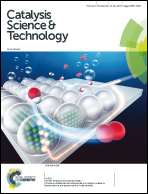Improving the water splitting performance of nickel electrodes by optimizing their pore structure using a phase inversion method†
Abstract
Porous nickel electrodes were fabricated by the phase inversion tape casting method. The as-prepared nickel electrode contained finger-like straight open pores with an average diameter of ∼100 μm and smaller pores with an average diameter of 1–3 μm in the walls. When used as an anode for the oxygen evolution reaction (OER), the porous nickel electrode shows high catalytic activity, reaching a catalytic current density of 10 mA cm−2 under an overpotential of only 300 mV in 1.0 M KOH. It also exhibited excellent performance for the hydrogen evolution reaction (HER), resulting in a current density of 10 mA cm−2 under an overpotential of 125 mV in the same electrolyte. For both OER and HER, the electrode shows great catalytic stability and much better catalytic performance than commercial nickel foam. Moreover, an alkaline electrolyzer using identical porous nickel electrodes as both the anode and cathode required a cell voltage of only 1.65 V to reach 10 mA cm−2 for overall water splitting. The improved electrocatalytic performance of the electrode can be attributed to its unique dual-pore structure.



 Please wait while we load your content...
Please wait while we load your content...